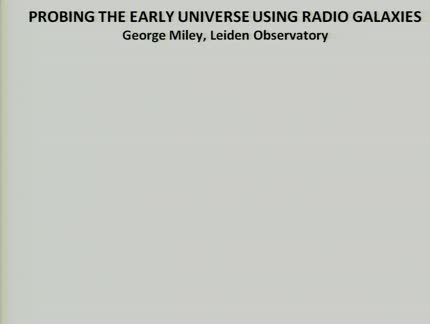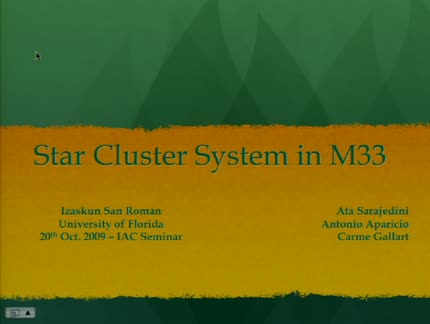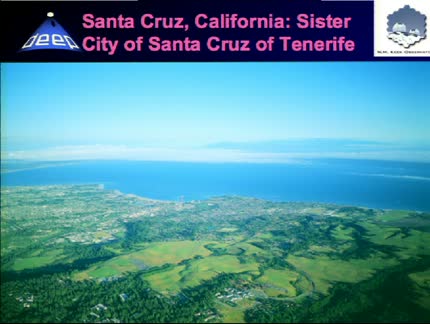Found 219 talks archived in Galaxies

Abstract
When we measure the electron density within an H II region using ratios of emission lines we find characteristic values in the range of 100-300 cm-3. But when we make these measurements using the total luminosity in Hα and the overall radial size of an H II region we find average values in the range 3-10. I will first explain how this discrepancy occurs, and then go on to show some measurements of electron densities in the H II regions of M51 (over 2500 regions) and the dwarf galaxy NGC 4449 (over 250 regions) using the second method, by Leonel Gutiérrez and myself. From these measurements we can infer how the electron density varies with the radial size of an individual region, and how it varies as we move from the center of the galaxy disc to the outside. Some interesting simple global relationships are found, which tell us about the interaction of star forming regions with their surroundings and how this interaction varies across the face of a galaxy.
Abstract
Luminous high-redshift radio galaxies (HzRGs) are associated with the most massive known galaxies in the early Universe. These galaxies have the properties expected of the progenitors of dominant galaxies in rich clusters.
I shall describe the properties of HzRGs and demonstrate how they can be used to study the formation and evolution of galaxies and clusters. I shall also show how LOFAR, the new European radio telescope, can be used to extend these probes into the epoch of reionisation.

Abstract
We test the theoretical prediction that the straightest dust lanes in bars are found in strongly barred galaxies, or more specifically, that the degree of curvature of the dust lanes is inversely proportional to the strength of the bar. The test uses archival images of barred galaxies for which a reliable non-axisymmetric torque parameter (Qb) and the radius at which Qb has been measured (r(Qb)) have been published in the literature. Our results confirm the theoretical prediction but show a large spread that cannot be accounted for by measurement errors. We simulate 238 galaxies with different bar and bulge parameters in order to investigate the origin of the spread in the dust lane curvature versus Qb relation. From these simulations, we conclude that the spread is greatly reduced when describing the bar strength as a linear combination of the bar parameters Qb and the quotient of the major and minor axes of the bar, a/b. Thus, we conclude that the dust lane curvature is predominantly determined by the parameters of the bar.

Abstract
I will present grid-adaptive computational studies of both magnetized and unmagnetized jet flows, with significantly relativistic bulk speeds, as appropriate for AGN jets. Our relativistic jet studies shed light on the observationally established classification of Fanaroff-Riley galaxies, where the appearance in radio maps distinguishes two types of jet morphologies. We investigate how density changes in the external medium can induce one-sided jet decelerations, explaining the existence of hybrid morphology radio sources. Our simulations explore under which conditions highly energetic FR II jets may suddenly decelerate and continue with FR I characteristics. In a related investigation, we explore the role of dynamically important, organized magnetic fields in the collimation of the relativistic jet flows. In that study, we concentrate on morphological features of the bow shock and the jet beam, for various jet Lorentz factors and magnetic field helicities. We show that the helicity of the magnetic field is effectively transported down the beam, with compression zones in between diagonal internal cross-shocks showing stronger toroidal field regions. For the high speed jets considered, significant jet deceleration only occurs beyond distances exceeding hundred jet radii, as the axial flow can reaccelerate downstream to internal cross-shocks. This reacceleration is magnetically aided, due to field compression across the internal shocks which pinch the flow.
Abstract
Galaxies are the basic building blocks of the Universe, and understanding their formation and evolution is crucial to many areas of current astrophysical research. Nearby galaxies, being the 'fossil record' of the evolution of galaxies, provide a wealth of detail to test extensively the current models of galaxy formation and evolution. A galaxy's structure is linked to both its mass and evolutionary history. Probing galactic structure requires understanding the distribution of stars among galaxies of all types and luminosities across the full range of environments. We are performing a complete volume-limited (d < 40 Mpc) survey of over 2200 nearby spiral, elliptical and dwarf galaxies at 3.6 and 4.5 μ in the Spitzer Warm Mission to address fundamental questions of galactic structure that are united by the common need for deep, uniform, unbiased maps of the stellar mass in galaxies. I will introduce the survey, give examples of images and of the science that can be done, and explain how other researchers at the IAC can become involved in analysing these exciting data.
Abstract
ΛCDM-based numerical simulations predict a scenario consistent with observational evidence in Milky Way-like halos. However, less clear is the role of low-mass galaxies in the big picture. The best way to answer this question is to study the nearest example of a dwarf spiral galaxy, M33. We will use star clusters to understand the structure, kinematics and stellar populations of this galaxy. We will present our current status and future plans of a comprehensive study of the star cluster system of M33. This study will provide key insights into the star formation history, composition and kinematics of low-mass galaxies as well as place M33 within the context of galaxy formation process.
Abstract
AEGIS (All-wavelength Extended Groth strip International Survey: aegis.ucolick.org) is on-going survey that opens up new views of the development of galaxies and AGN's at redshifts z about 1. AEGIS is panchromatic like GOODS, with coverage ranging from X-ray to radio, and nearly as deep but more panoramic by covering a 4x larger region. Its backbone is the most Northern (accessible to the GTC) of the four fields of the DEEP2 Keck spectroscopic survey, which provides not only precision redshifts that yield reliable pairs, groups, and environments, but also internal kinematics and chemical abundances. After an overview of the DEEP and AEGIS surveys, I will share some recent highlights, including using a new kinematic measure for distant galaxies to track Tully-Fisher-like evolution; discovering metal poor, massive, luminous galaxies; finding ubiquitous galactic gas outflows among distant star forming galaxies; and exploring the nature of distant x-ray AGNs.
Abstract
The coalescence of a massive black hole (MBH) binary leads to the gravitational-wave recoil of the system and its ejection from the galaxy core. We have carried out N-body simulations of the motion of a M=3.7 M⊙ MBH remnant in the “Via Lactea I” Milky Way-sized halo. The hole receives a kick velocity of Vkick = 80, 120, 200, 300, and 400 km/s at redshift 1.5, and its orbit is followed for over 1 Gyr within a “live” host halo, subject only to gravity and dynamical friction against the dark matter background. We show that, owing to asphericities in the dark matter potential, the orbit of the MBH is highly non-radial, resulting in a significantly increased decay timescale compared to a spherical halo. The simulations are used to construct a semi-analytic model of the motion of the MBH in a time-varying triaxial Navarro-Frenk-White dark matter halo plus a spherical stellar bulge, where the dynamical friction force is calculated directly from the velocity dispersion tensor. Such a model should offer a realistic picture of the dynamics of kicked MBHs in situations where gas drag, friction by disk stars, and the flattening of the central cusp by the returning hole are all negligible effects. We find that, in a Milky Way-sized galaxy, a recoiling hole carrying a gaseous disk of initial mass ~2 MBH may shine as a quasar for a substantial fraction of its “wandering” phase. The long decay timescales of recoiling MBHs predicted by this study may thus be favorable to the detection of off-nuclear quasar activity.
Abstract
In the local universe, galaxies fall into one of two populations: a star-forming blue cloud and a red sequence lacking star formation. At redshift z ~ 1.5, however, the red sequence has yet to develop. Over the past 9 Gyrs some process has quenched star formation in blue galaxies and caused them to evolve onto the red sequence by fading and/or merging of their stellar populations. While such a transformation may be occurring across the full range of masses, the highest rate of evolution occurs in massive starbursts at the luminous end of the blue cloud. These galaxies are the Luminous Compact Blue Galaxies (LCBGs). In this talk I present preliminary results of a comprehensive multiwavelength survey of LCBGs from z ~ 0 to z ~ 3 we will be carrying out over the next 5 years using several space and ground-based observatories, including the GTC.

Abstract
The SAURON survey has revised our view of early type galaxies discovering that central disks and multiple kinematic components are common; 75% of the sample have extended ionized gas, often misaligned with the stars; half of S0s and 25% of Es have intermediate age populations. There is a tight relationship between the escape velocity and Mg line strength which holds both within and between galaxies raising uncomfortable questions for hierarchical assembly. Many of the properties of ETGs are related to a measure of their specific angular momentum : slow rotators are triaxial, close to spherical, isotropic and frequently exhibit decoupled central kinematics, whereas fast rotators are intrinsically flatter, oblate, have disk-like (anisotropic) kinematics and often have Mg enhanced disks. In general the slow rotators are more massive and have older populations Only half of the elliptical galaxies exhibit slow rotation, the remainder have stellar disks showing that the historic division by morphological class is physically misleading. We suggest that the contrasting physical properties of fast and slow rotators arise through distinct assembly histories with slow rotators forming in gas free, dry mergers and fast rotators retaining a disk component through a dissipative merger.Upcoming talks
- TODAY: Runaway O and Be stars found using Gaia DR3, new stellar bow shocks and search for binariesMar Carretero CastrilloTuesday April 30, 2024 - 12:30 GMT+1 (Aula)
- Detecting GWs in the muHz: natural and artificial satellites as GW detectorsProf. Diego BlasThursday May 2, 2024 - 10:30 GMT+1 (Aula)









